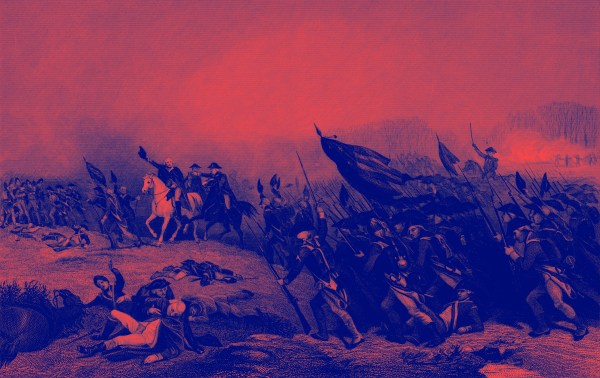White Noise opens with an awkward Halloween party attended by a collection of alt-right personalities, hosted by Lucian Wintrich—best known for his brief stint as a White House correspondent for the far-right blog Gateway Pundit—in Washington, D.C. There’s a knock at the door; Wintrich hops up from the couch, brimming with excitement as Lauren Southern, the renowned Canadian anti-immigration activist, makes an appearance. The two embrace. Southern is wearing a black cape, pale makeup, and cheesy plastic vampire teeth. “I’m the IRS,” she quips.
It’s an oddly human moment for a group of characters that are almost exclusively portrayed as a sinister monolith: The superabundance of documentaries, investigative articles, books and internet shorts on the alt-right that have materialized in the years since Donald Trump’s rise to power are, as a general rule, sensationalist and partisan affairs. Conventional treatments of the coalition of activists, commentators, writers and internet personalities tend to paint the predominantly internet-based movement as an ominous cult of evil with enormous—and ever-increasing—influence in the American political arena.
But White Noise takes a different approach. The new documentary features 27-year-old Atlantic filmmaker Daniel Lombroso following a handful of the alt-right’s most notorious figures for the better part of four years, providing an intimate portrait of a collection of lost, desperately unhappy young men—and, to a lesser extent, women—searching for meaning in a fringe ideology. While most of the mainstream coverage of the alt-right spends little, if any, actual time with its adherents—previous documentaries like Age of Rage give the significant majority of airtime to “anti-fascist” activists and Southern Poverty Law Center intellectuals—Lombroso seeks to understand the alt-right as it is; made up of real people rather than a faceless force of darkness.
Viewers gain not just a richer understanding of the profound ugliness of the movement’s devotées but also of the conditions responsible for producing such ugliness: a sense of loneliness in an age of interconnected mass culture, and a yearning for community in an increasingly atomistic world. Acolytes of the alt-right are often portrayed as larger-than-life supervillains; White Noise reveals them to be broken, deeply isolated individuals.
Besides Lauren Southern, Pizzagate promulgator Mike Cernovich and white supremacist Richard Spencer are the main subjects of the documentary, although other major figures make tangential appearances. The three prominent personalities each represent a different subgenre of the alt-right: Spencer stands in for the dyed-in-the-wool white nationalists, Cernovich for the Trumpist conspiracy theorists, and Southern the hard-right grifters. All three have taken on outsize roles in our political discourse; but in Lombroso’s documentary they become more visibly human.
What is notable about the film, then,is less its explosively disturbing moments—the Nazi salutes in Washington, D.C., on the heels of Trump’s victory, the deadly chaos of the 2017 Unite the Right rally in Charlottesville—but rather the dreary routine of the piteous lives lived in the empty spaces in between them.
In White Noise, Spencer is not the leader of a neo-fascist insurgency on the brink of conquering America, but a divorced outcast who, at the age of 42, has moved back in with his mother. One sees Spencer lurching from one failure to another, a man perpetually frustrated by his inability to be loved by a world that has rejected him. For every Charlottesville, there are 100 speeches given to mostly empty rooms, events canceled at the last minute by venues horrified by Spencer’s ideology, and profanity-laden public humiliations at the hands of strangers.
“2018 has been one of the hardest years of my life,” he tells Lombroso. “I’ve had a failed marriage, multiple lawsuits, I can’t raise money the way that I had been, I’m being treated like a terrorist. … I’ve never been put through this s**t. And it’s just awful.”
Spencer’s desperation is a consistent fact of life for the documentary’s cast of characters. Cernovich, also divorced, is revealed to be living off of his ex-wife’s paycheck. (“It’s pretty alpha,” he argues, “to get paid alimony by a woman.”) Like Spencer, Cernovich has been made out to be a cunning political savant by mainstream commentators—described as “someone to reckon with” whose influence “reach[es] the highest seats of power” by the SPLC—but he leads something of a dismal, bleak existence: “I’m not someone who likes myself particularly much,” he confesses at one point. “I’m not somebody who wakes up and thinks, ‘I really like me. I really like this person.’”
Southern, for her part, seems to be increasingly uncomfortable with the ideology she publicly promotes as the film wears on, visibly cringing when her then-boyfriend informs her that his primary motivation for raising a family is the fact that “us Europeans, we have responsibility to reproduce,” and awkwardly dodging alt-right provocateur Gavin Mcinnes’s drunk sexual advances. (Southern was 23 at the time; Mcinnes was 48, and married with three children).
In this way, the documentary is about more than the alt-right; it’s an examination of the ugly underbelly of our technological age. Its characters are, after all, all creatures of the internet, and their followers are disproportionately composed of isolated young people searching for a sense of belonging in an online ecosystem of forums, YouTube channels and message boards. As an especially disturbing phenomenon, the alt-right is unique; but as a manifestation of the widespread inclination to find purpose in a political community, it’s merely one particularly vile manifestation of a universally felt impulse.
Above all else, White Noise is a sort of unsympathetic eulogy for a dying movement; a portrait of a cohort whose brief moment is decidedly over. Over the four-year span of the film, we see its peak as well as its sorry decline—while watching its proponents attempt to reconcile themselves to a country far less receptive to their ambitions than they had once hoped.
Nate Hochman (@njhochman) is an ISI summer fellow for The Dispatch.






Please note that we at The Dispatch hold ourselves, our work, and our commenters to a higher standard than other places on the internet. We welcome comments that foster genuine debate or discussion—including comments critical of us or our work—but responses that include ad hominem attacks on fellow Dispatch members or are intended to stoke fear and anger may be moderated.
With your membership, you only have the ability to comment on The Morning Dispatch articles. Consider upgrading to join the conversation everywhere.